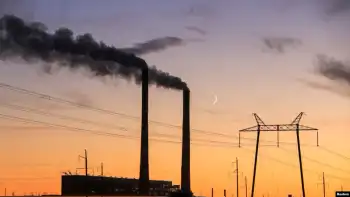Future of coal power under fire
WASHINGTON, D.C. - Coal-producing states that supply nearly half of the nation's electricity are feeling squeezed as efforts to combat global warming outpace technology needed to make the nation's most abundant fossil fuel burn more cleanly.
In 2007, proposals for 59 coal plants were scrapped in 24 states, either by state regulators concerned about the effects of carbon-dioxide emissions or by power companies worried about the future costs of pollution, according to data from the Sierra Club. Now, governors and other officials from major mining states are intensifying calls to expand technologies to reduce carbon-dioxide emissions from coal power, including a method that turns carbon dioxide into a synthetic natural gas, called gasification, or to store the emissions underground, through a process called sequestration.
"Whether you believe in global warming or not, the political and economic realities have changed, and Wyoming needs to adapt to those changes," said Gov. Dave Freudenthal, a Democrat, after signing two bills to establish new rules governing sequestration in his state, which produces more than 38 percent of the nation's coal. Seventeen states already provide financial incentives to encourage cleaner coal-burning technology.
North Dakota has the only plant that gasifies coal and pumps the synthetic natural gas to pipelines that supply the eastern United States - and also captures some of the carbon-dioxide emissions. The federal Department of Energy has helped build demonstration plants in Indiana and Florida that gasify coal to create electricity, and more than 30 proposed power plants would use similar technology, according to a February report from the National Energy Technology Laboratory (NETL).
Only three of them are in the final stages of planning or nearing construction, NETL reports. Coal is now burned in more than 600 plants to generate 49 percent of the country's current electricity, with the largest amounts of that fuel consumed in the upper Great Lakes and Southeastern states, according to the federal Energy Information Administration.
The National Mining Association (NMA) projects that the amount of coal mined this year will approach the 2006 record of 1.16 billion tons. While coal is mined in 26 states, more than two-thirds of it comes from Wyoming, West Virginia, Kentucky and Pennsylvania.
West Virginia employs the most miners, more than 20,000 in 2006. Nearly 18,000 coal miners worked in Kentucky that year and more than 5,800 in Wyoming. Although 150 new coal-fired power plants were proposed between 2000 and 2006, the bulk of those projects has been delayed or canceled, according to an October 2007 report by NETL.
More than 36,000 megawatts of electricity was scheduled to come from new coal-fired power in 2007 - enough to power roughly 36 million homes, just 4,500 megawatts was actually produced, NETL found. Carol Raulston, an NMA spokeswoman, points out that 28 new coal-fired power plants are under construction.
But clean-coal technology is not likely to be widespread commercially for 15 years to 20 years, she said. Coal is under fire for the amount of carbon dioxide the plants emit - the most prevalent greenhouse gas and widely accepted as a primary cause of global warming. Electric power generation from coal accounts for roughly 34 percent of U.S. greenhouse-gas missions.
State governments already are leading the movement to curb greenhouse gases, with 26 now requiring that a percentage of electricity come from renewable sources, such as wind and solar. Those include five of the top 10 coal-producing states - Pennsylvania, Montana, Texas, Colorado and Illinois.
Nearly all of those 26 states also have signed on to three separate, regional cap-and-trade systems that will eventually require cuts in carbon-dioxide emissions from power plants and other industrial sources. Under those systems, coal-fired power plant would be given or have to buy credits for the carbon dioxide they produce and pay for additional credits if they do not meet reduction targets.
Now, some state regulators are taking more direct aim at coal. Last year, officials in Kansas and Washington became the first in the nation to reject proposals for new coal-fired power plants specifically because of concerns over climate change.
Kansas and Washington are both involved in multi-state agreements to cap carbon-dioxide emissions. Washington also has passed a law to cut greenhouse gases in the state 50 percent below 1990 levels by 2050.
"I believe it would be irresponsible to ignore emerging information about the contribution of carbon dioxide and other greenhouse gases to climate change and the potential harm to our environment and health if we do nothing," said Roderick Bremby, secretary of the Kansas Department of Health and Environment, in written comments explaining his decision.
The Kansas Legislature passed a bill March 6 to overrule the department's denial of the power plant and block similar decisions in the future.
Gov. Kathleen Sebelius, a Democrat, has promised to veto that legislation.
Related News

Electric Ferries Power Up B.C. with CIB Help
VANCOUVER - British Columbia is taking a significant step towards a cleaner transportation future with the electrification of its ferry fleet. BC Ferries, the province's ferry operator, has secured a $75 million loan from the Canada Infrastructure Bank (CIB) to fund the purchase of four zero-emission ferries and the necessary charging infrastructure.
This marks a turning point for BC Ferries, which currently operates a fleet reliant on diesel fuel. The new Island-class electric ferries will be deployed on shorter routes, replacing existing diesel-hybrid vessels. These hybrid ferries will then be redeployed on routes that haven't yet been converted to electric,…




